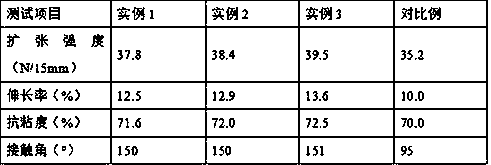A method for preparing waterproof cellophane
A technology of cellophane and preparation steps, which is applied in the field of preparation of waterproof cellophane, which can solve the problems of easy water absorption and deformation of cellophane, and achieve the effects of improved compactness, improved water resistance, and reduced hydroxyl content
- Summary
- Abstract
- Description
- Claims
- Application Information
AI Technical Summary
Problems solved by technology
Method used
Image
Examples
example 1
[0024] Mix 100mL liquid paraffin with 200mL distilled water in a two-necked flask with a stirrer, heat to 60℃, add 3gOP-10 to 100mL distilled water, stir for 10min to obtain a water emulsion, preheat the water emulsion to 60℃ , Put into a two-necked flask, start the stirrer, stir at 200r / min and emulsify for 40min to obtain emulsified liquid paraffin; add 0.8gOP-10 to 40mL acrylic acid, stir for 20min to obtain emulsified acrylic acid, emulsify acrylic acid and emulsify The liquid paraffin was placed in a three-necked flask with a stirrer and a dropping funnel, heated to 70°C, started the stirrer to stir and emulsify for 20 minutes at a speed of 300r / min, and then used the dropping funnel at a dropping rate of 5mL / min. Add 40 mL of 10% potassium thiosulfate solution to a three-necked flask. After the addition is complete, stir and react for 40 minutes to obtain modified emulsified liquid paraffin; put the sugar cane in a sugarcane juicer for 20 minutes to extract the juice to ob...
example 2
[0026] In a two-necked flask with a stirrer, mix 105mL liquid paraffin with 210mL distilled water, heat to 63℃, add 4gOP-10 to 110mL distilled water, stir for 13min to obtain a water emulsion, preheat the water emulsion to 63℃ , Put into a two-necked flask, start the stirrer, stir at 215r / min and emulsify for 43min to obtain emulsified liquid paraffin; add 0.9g OP-10 to 45mL acrylic acid, stir for 23min to obtain emulsified acrylic acid, emulsify acrylic acid and emulsify The liquid paraffin was placed in a three-necked flask with a stirrer and a dropping funnel, heated to 73°C, and the stirrer was started to stir and emulsify for 25 minutes at a speed of 325r / min. Then, the dropping funnel was used at a dropping rate of 6mL / min. Add 43mL of 10% potassium thiosulfate solution to the three-necked flask. After the addition is complete, stir and react for 45 minutes to obtain modified emulsified liquid paraffin. Put the sugarcane in a sugarcane juicer for 23 minutes to extract the ...
example 3
[0028] Mix 110mL of liquid paraffin with 220mL of distilled water in a two-necked flask with a stirrer, heat to 65℃, add 5gOP-10 to 120mL of distilled water, stir for 15min to obtain a water emulsion, preheat the water emulsion to 65℃ , Put into a two-necked flask, start the stirrer, stir at 230r / min, stir and emulsify for 45min to obtain emulsified liquid paraffin; add 1.0gOP-10 to 50mL acrylic acid, stir for 25min to obtain emulsified acrylic acid, emulsify acrylic acid and emulsify The liquid paraffin was placed in a three-necked flask with a stirrer and a dropping funnel, heated to 75°C, the stirrer was started to stir and emulsify for 30 minutes at a speed of 350r / min, and then the dropping funnel was used at a dropping rate of 7mL / min. Add 45 mL of 10% potassium thiosulfate solution to a three-necked flask. After the addition is complete, stir and react for 50 minutes to obtain modified emulsified liquid paraffin; put the sugarcane in a sugarcane juicer for 25 minutes to e...
PUM
 Login to View More
Login to View More Abstract
Description
Claims
Application Information
 Login to View More
Login to View More - R&D
- Intellectual Property
- Life Sciences
- Materials
- Tech Scout
- Unparalleled Data Quality
- Higher Quality Content
- 60% Fewer Hallucinations
Browse by: Latest US Patents, China's latest patents, Technical Efficacy Thesaurus, Application Domain, Technology Topic, Popular Technical Reports.
© 2025 PatSnap. All rights reserved.Legal|Privacy policy|Modern Slavery Act Transparency Statement|Sitemap|About US| Contact US: help@patsnap.com


